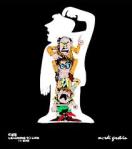
One in three girls will be abused by the age of eighteen.
One in seven children has already been abused.
How many do you know? How many of your friends, relatives and colleague have come public with it? How many are still ruled by shame and guilt? And how can you, as a friend, a partner or a therapist, help them cope with it and eventually overcome the trauma it created? Here are a few things to know and a few tips to help handling it:
1. The Social Stigma
Unfortunately in our society, there are still a lot of stigma attached to sexual abuse. There are still a lot of limiting beliefs around rape for example such as “If she was raped it’s because of how she dressed” or “He must have provoked him sexually”. Those stigma unfortunately creates shame in the victims of sexual abuse, who then prefer to hide what happened to them by fear of being verbally and emotionally attacked. And by doing so, they end up feeling ostracised, different and isolated in their pain.
How can you help? If you suspect someone close to you has been abused at any point in their past, casually let them know you would never judge or condemn a victim of sexual abuse ; that you empathise with them and you know it must be difficult to handle that on their own. That will allow them to relax as they hear a different opinion than the one they are scared of. That may even encourage them to share with someone what happened to them, which is the first step to healing.
2. Guilt
The most common thoughts that trigger guilt in abuse victims are along the line of “what did I do to trigger it?”, “I must have sent a vibe that made him think it was ok” ; “I didn’t stop it so I’m accomplice of the abuse” ; “I didn’t talk about it, I didn’t denounce them” ; “I allowed it to happen”. Especially when the victim was abused as a child, those thoughts are very likely to poison their life. Because as an adult they revisit the event from the point of view of an adult, with the resources and knowledge they have now, judging the child as if she had those resources back then. And naturally that leads them to start to question and blame themselves as to why they didn’t do something about it.
How can you help?
Remind them that as a child, they didn’t have the knowledge or resources they have now as an adult. And as a result, they might not even have known that what was going on wasn’t normal ; Or that they were scared to rebel against an adult’s authority ; or they didn’t have the ability to run away and thus survive on their own without the care and support of those adults ; or that they were manipulated by knowledgeable adults who used their child’s naivety and innocence. In any case, it is very important to remind them that back then they were only a child, and couldn’t have done anything different. And that their guilt comes from their judgement as an adult on themselves as a child.
If you’re working therapeutically with someone, I would suggest an approach like re-parenting to start with, for your client to begin to forgive themselves for something they were absolutely not responsible for. You could also work with that specific aspect using EFT to eliminate the guilt.
3. Shame
In some cases, the abuse was linked with physical or emotional pleasure. Physical, as in their erogenous zones were stimulated, and emotional as in it might have created a bond between the victim and the abuser. A young child wouldn’t necessarily yet have the tools to distinguish what is healthy to what is not in terms of sexuality. The abuse is likely to be their first ever encounter with sexuality, and as such they wouldn’t know yet what are the rules around it. They might have felt some pleasure as a result, simply because it wouldn’t yet have been censured in their mind – especially if that would have been presented to them as a game.
Another type of shame comes from emotional pleasure. The abuser could have used sex as a bargaining tool, giving the child a message like “I love you if you do that for me”. Children are very vulnerable and in their early years absolutely need to be loved in order to develop properly.
How can you help?
To start with, remind them that our bodies are designed to respond mechanically to sexual excitement, and pleasure would have simply meant that their body physiology and biology worked very well. Not that they enjoyed being abused. Remind them also that young children would be driven by the need of survival, and as a result would have complied to the abuse unconsciously in order to receive the love and care they needed to survive. Asking the question to an abuse survivor “If you hadn’t complied as a child, what would have happened to you” generally helps to understand that their unconscious choice was made to guarantee their survival and safety.
Therapeutically I would also recommend EFT and re-parenting to work on those specific aspects, as well as NLP processes such as Reimprinting or Core Transformation.
4. Feeling worthless and self-esteem issues
Sadly most of the time the child will have been manipulated and made to believe that what happened was their fault ; They have probably been given the message that they were a bad person, or worthless as a way for the abuser to justify themselves in that behaviour.
Unfortunately the child would have been too young to understand that twisted psychological manipulation and would have likely believed the abuser and absorbed that belief at a deep unconscious level. Which would have then stayed with them and created in their adult life a lot of self-esteem and self-image issues.
How can you help?
Explain to them or lead them to understand the root of that belief and how it is completely mistaken.
Therapeutically I would do a lot of work on rebuilding self esteem, self confidence and self love, once the root cause of the belief has been identified and cleared.
5. Anger
Naturally the abuse would have created a lot of anger in the victim, and until the abuse has been worked through therapeutically, that anger might still be very present in their life. Whether it’s anger towards the abuser, a parent that didn’t believe or protect them or even anger towards themselves, at some point this hatred and anger could begin destroying them ; by making their lives miserable or even worst, by turning into an illness.
The body is very good at physically manifesting destructive emotions. And anger is one of the strongest emotion and often at the root of many illnesses.
How can you help?
Encourage the victim in expressing out loud their anger towards the abuser or the parent who wasn’t there for them at the time of the trauma, either in a Gestalt stair exercise or through Reimprinting ; or perhaps through writing them a letter they may or may not want to send them. Anger needs to be expressed in order to disappear. If it’s kept inside, it will fester and manifest itself in another way.
In terms of self anger, the victim needs to understand rationally that they were not at fault and are not to blame. Once that understanding exists, there’s a lot of work to do around self-forgiveness and self-acceptance.
6. Sexual dysfuncions
It is logically quite common in victim of abuse to develop sexual dysfunctions. From promiscuous behaviours to fear of intimacy, a lot of issues can stem from the trauma. To name a few, fear of men (if the abuser was a man), frigidity, erectile dysfunctions, difficulty to orgasm and sometimes sexual diseases or discomfort.
How can you help?
Sex therapy is a good place to start. As a partner of a sexual abuse victim, a very open communication on what emotions or memories are triggered for them during intimacy will help create trust and relaxation that could be the beginning of healing. Let your partner know that they are welcome to share at any point any time if they feel discomfort and something is triggered for them, so they can start interrupting the unconscious associations between current sexual intimacy and the past abuse.
7. Trust issues
It is understandable that after having been manipulated, deceived and betrayed, the child learns not to trust. The default nature of a child is to trust adults, and an adult taking advantage of that innocence will teach the child at the unconscious level that trusting is dangerous all together with anyone at any time.
How can you help?
Start with understanding that the lack of trust isn’t personal and allow yourself to disassociate from it in order to understand where that person comes from. Work together using patience and understanding to help them rebuild their trust, and learn to know who and when to trust.
I would always strongly recommend to work with a qualified therapist on sexual abuse and other type of trauma, as it lives in the unconscious mind and always has a ripple effect in the person’s life. That can vary from depression, to anger issues and sexual dysfunction, but because of the seriousness of the trauma, it is important to feel safe in the hands of a responsible experienced therapist that will be able to hold the space and keep you safe as you work your way through the abuse.
I hope this blog was helpful, it came about after having many discussions with clients having suffered abuse and feeling abnormal and isolated. My goal was to remove the taboo so if you’ve been abused, you know it’s ok to feel the way you feel, and that it’s much more common than you think.
If you have questions about the subject, please feel free to post them below or contact me directly, I’d be more than happy to have a conversation with you.








